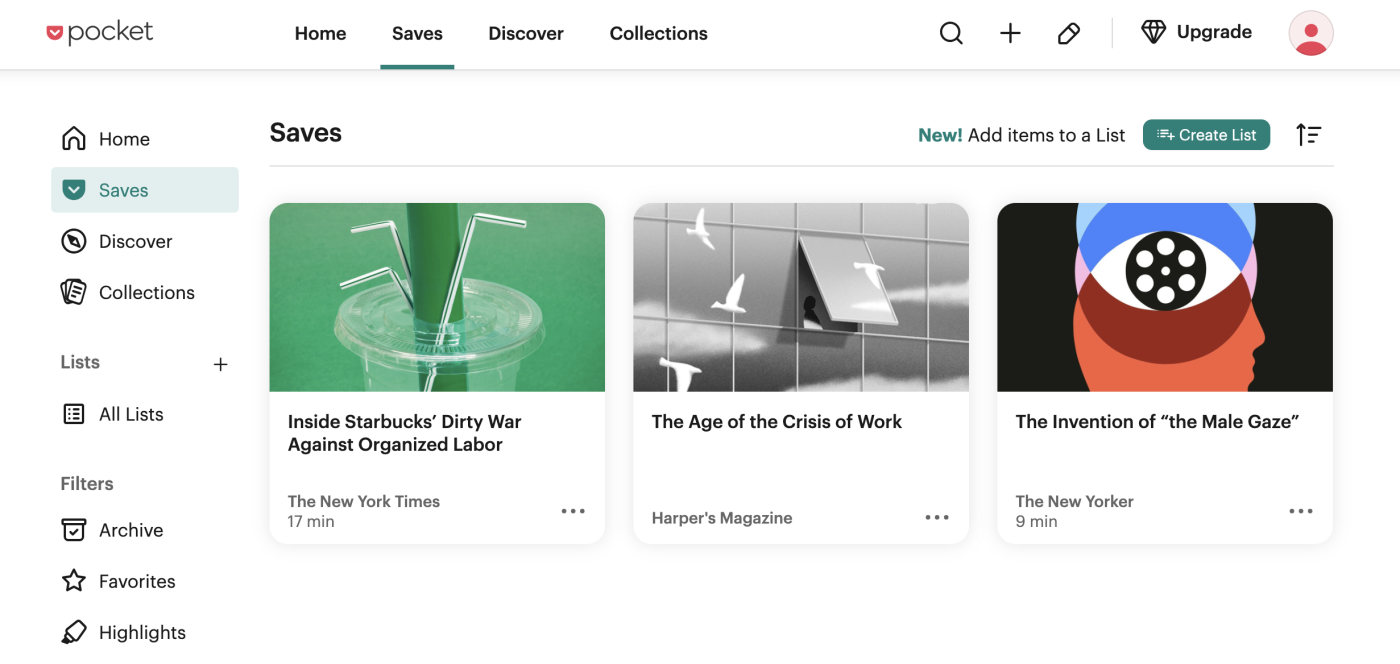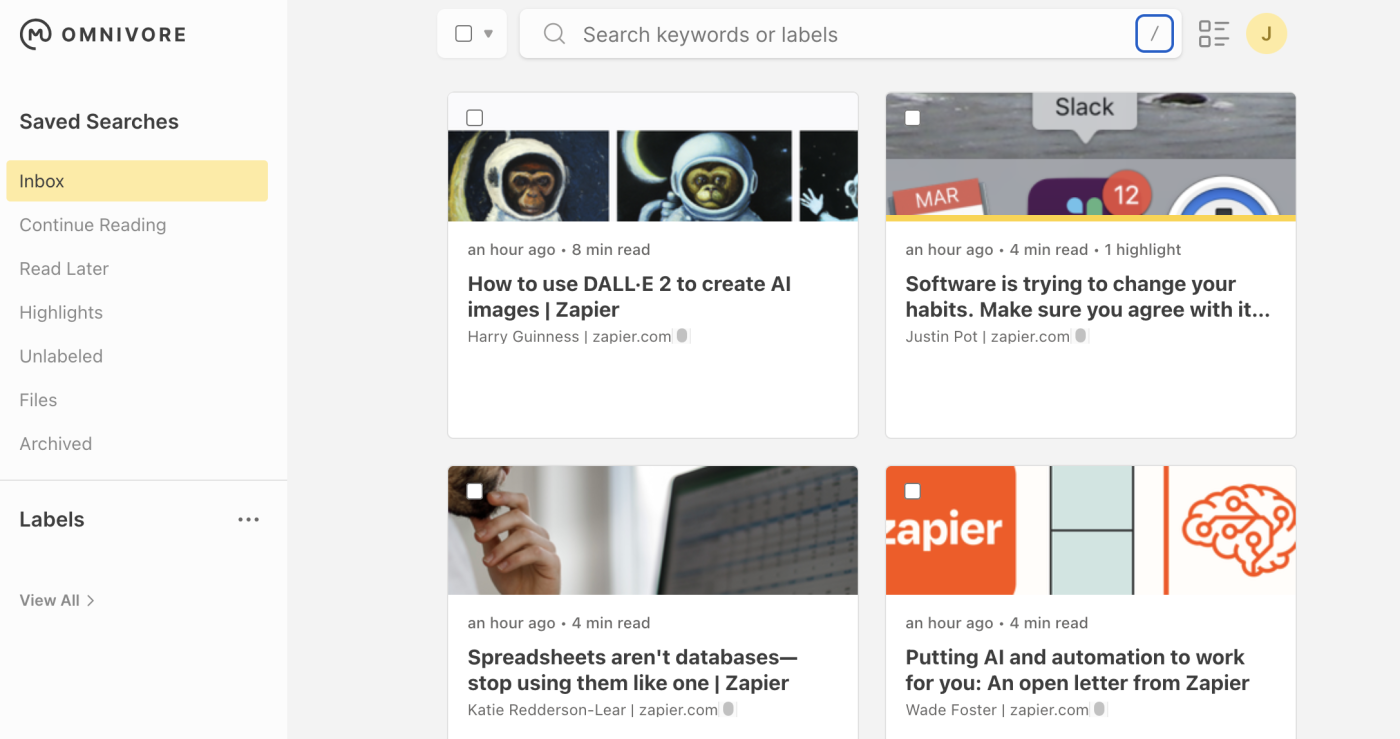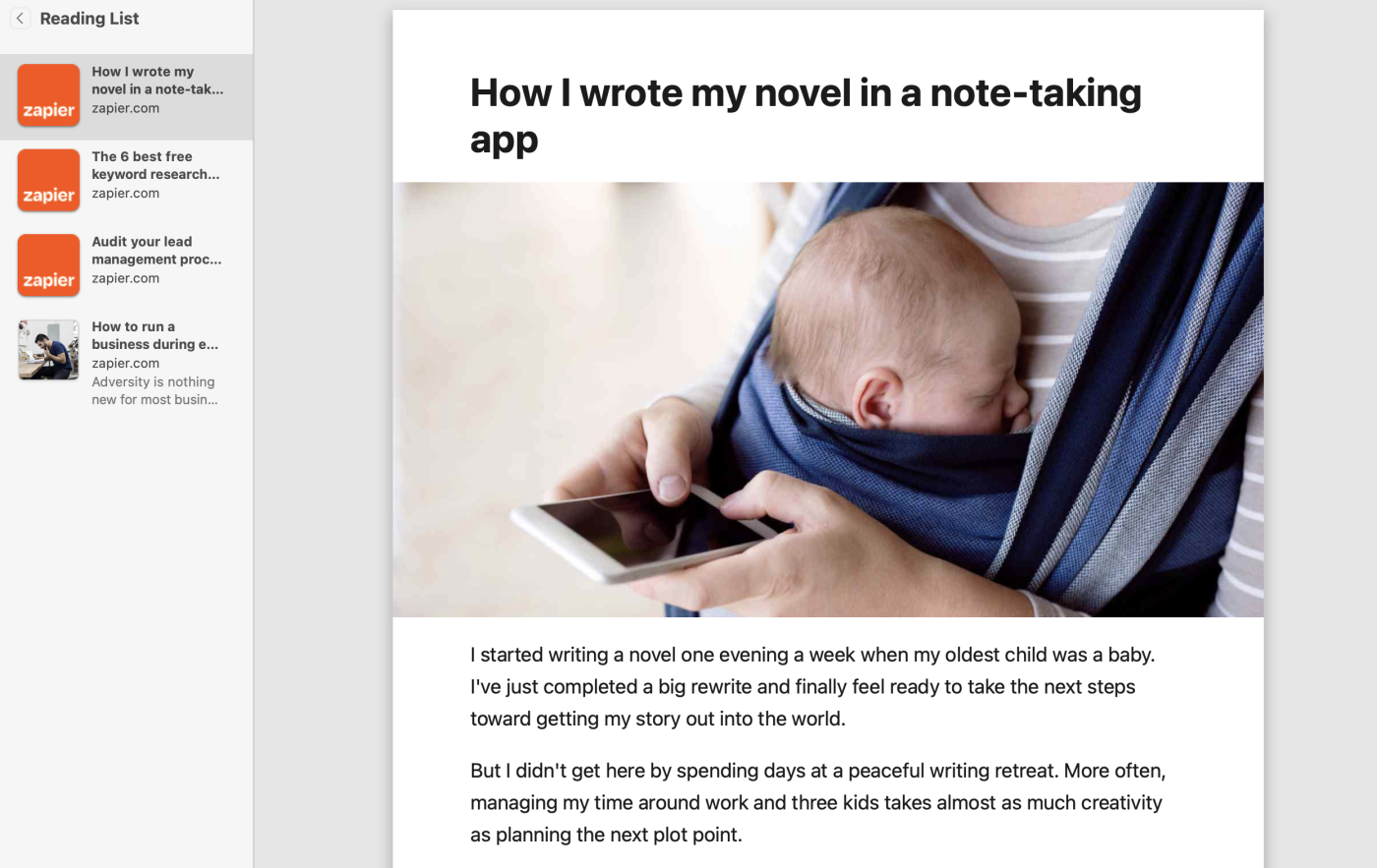Reading articles online is more interesting than most jobs. It's a big problem, and read it later apps are the solution.
I considered over 20 read it later apps, and after extensive testing, here are the four best.
If you're just looking for a bookmarking app, which stores links to articles but doesn't let you read them from within the app, here are our picks for the best bookmark and archiving apps.
The 4 best read later apps
Pocket for turning articles into a podcast
Instapaper for speed reading
Omnivore for reading newsletters later
Safari Reading List for Apple loyalists
What makes the best reading list app?
How we evaluate and test apps
Our best apps roundups are written by humans who've spent much of their careers using, testing, and writing about software. Unless explicitly stated, we spend dozens of hours researching and testing apps, using each app as it's intended to be used and evaluating it against the criteria we set for the category. We're never paid for placement in our articles from any app or for links to any site—we value the trust readers put in us to offer authentic evaluations of the categories and apps we review. For more details on our process, read the full rundown of how we select apps to feature on the Zapier blog.
Read it later apps do one thing: store articles you intend to read later. This is different from bookmarking apps, which simply store links to those articles, and different from note-taking apps, which can be used for clipping articles but aren't primarily designed with reading in mind.
So, what makes the best dedicated read later app? I'm glad you asked. I've been using one of these apps for over a decade, regularly switching between them in my quest to find the best offline reading experience possible. To me, the best read it later apps:
Let you save articles to read later in one click. Ideally there's a browser extension and a mobile app, but bookmarklets work in a pinch.
Download those articles for offline reading on your phone, tablet, eReader, and (ideally) computer for offline reading.
Offer custom typography and color schemes. At the very least, the best read later app should have both a dark and a light mode, but the more options the better.
Make it easy to organize your archive of articles. Tags and folders are both great, and ideally you can also highlight things for future reference.
Work on as many platforms as possible. You need to be able to save an article on one device and read it on another, seamlessly.
I tested the most popular reading list apps on the market using these criteria.
The best read it later apps at a glance
Best for | Standout feature | Pricing | |
|---|---|---|---|
Turning articles into a podcast | Balance of powerful features and ease of use | Free plan available; $4.99/month for Pocket Premium | |
Speed reading | Can send to Kindle | Free plan available; $2.99/month for Instapaper Premium | |
Reading newsletters | Open source and easy to integrate with anything | Free | |
Apple loyalists | Built into Safari | Free on Apple devices |
The best read it later app for turning articles into a podcast
Pocket (Android, iOS, Web)

Pocket pros:
Built into many apps and devices
Feature complete and still easy to use
Pocket cons:
No notes feature
Pocket is the most feature-complete read it later app on the market. There's a web app, mobile apps, and a surprising number of apps also have a Pocket integration built in, thanks to a robust API. You won't have any trouble sending articles to Pocket.
You also won't have any problem reading those articles—they're extracted cleanly and show in a clutter-free environment. You can also control how your articles look: there's a dark, paper, and light color scheme, along with a couple of font choices in the free version.
Pocket is built for reading, but it can also read to you using a surprisingly lifelike text-to-speech engine. Tap the audio button in the mobile app, and your phone will read articles to you. The voices are passable, if a little robotic, and you can adjust the playback speed if need be. It's the best way to turn an article into a podcast short of hiring voice actors, and perfect if you want to cook dinner or go for a walk while catching up on your reading.
There are also plenty of options for sorting your reading list after reading. The main reading list is meant for articles you haven't read yet—you can archive things you're done reading, keeping this list as an inbox of articles for later. You can mark archived articles as favorites for future reference, then organize them using tags. You can also highlight key phrases as you read, allowing you to reference them later.
Want to do more with your articles? Connect Pocket to your favorite apps through Zapier. You can create automated workflows that automatically send links from tweets you like over to Pocket, or even send every article in an RSS feed over. Those are just examples—you can customize your workflow with thousands of apps.
Pocket pricing: Free; $4.99/month Pocket Premium for a permanent personal backup of the articles you've saved, suggested tags, full-text search, and more.
Want to learn more about Pocket? Check out our complete guide to using Pocket.
Best read it later app for speed reading
Instapaper (Web, iOS, macOS, Android, Kindle)

Instapaper pros:
Extremely simple
Can send articles to Kindle devices
Offers a speed reading feature
Instapaper cons:
No search in free version
Instapaper, more than any app I can think of, is all about simplicity. There's not a lot of color or graphics in the user interface—the focus is entirely on text. This is an app designed with readers in mind, which makes sense given what it's for.
Saving articles is simple thanks to extensions for every major browser, and there's a bookmark you can use if that doesn't work for you. Reading happens in the mobile apps for Android and iOS, both of which support offline reading, or on the website if you're on your computer. The reading experience is clean, with custom font and color choices.
The unique feature here is the speed reading button, which flashes one word at a time in quick succession. You can adjust the speed, if you want, but the idea is that this forces you to keep reading in a way that results in getting through articles more quickly. It's interesting but probably not for everyone.
There are also plenty of tools for organizing your articles. The Home screen is meant to contain articles you haven't read yet, and you can archive articles when you're done. There's a folder for articles you "liked" by default, and you can also add as many folders as you like for sorting articles by topic.
There are a few features offered by Instapaper that Pocket doesn't have. You can highlight quotes in an article, as in Pocket, but you can also add notes, which Pocket doesn't offer. You can also browse all of your highlights and notes in one place, without having to open the articles again. This makes Instapaper a great way to review your thoughts after reading. Instapaper also offers built-in support for sending articles to a Kindle eReader. If any of these features appeal to you—or you're looking for a Pocket alternative—Instapaper is probably the app for you.
You can automate your reading workflows with Instapaper's Zapier integrations, which let you do things like automatically send articles from tweets you like over to Instapaper or send every article from an RSS feed to your reading list. You can customize these workflows to use your favorite apps.
Instapaper pricing: Free; Instapaper Premium for $2.99/month offering full-text search for all of your articles, unlimited notes, and text-to-speech.
There are two clear frontrunners in this space, if you haven't noticed. Be sure to check out our Instapaper vs. Pocket showdown to learn more about how these two apps match up.
Best read it later app for newsletters
Omnivore (Web, iOS, Android, Mac)

Omnivore pros:
Free and open source
Can pull in newsletters automatically
Webhooks and other integrations (including Obsidian) available
Omnivore cons:
Newer app that occasionally feels buggy
Android app is currently in beta
Omnivore is the newest app on this list, and it shows: it's a little rough around the edges. The Android version is still a beta, for one thing, and the Mac version is missing most of the features found in the web version.
Still, if you look past the rough edges, there's a lot to like. Saving articles is easy using either a browser extension or the mobile app. The reading experience, on most devices, is also great: you've got four color schemes and thirteen fonts to choose from. Another big plus: the software is completely free as of this writing, and there's even the possibility of hosting the service yourself.
A standout feature is the ability to sign up for email newsletters. Omnivore can generate email addresses for you, which you can use to sign up for newsletters—new articles will show up directly in your mailing list. It's a great way to subscribe to email newsletters without clogging up your inbox. A more nerdy feature is integrations. Omnivore can be set up to save your highlights and notes to Obsidian, which is one of the best note-taking apps. There's also extensive support for webhooks, meaning you could in theory connect Omnivore to just about anything.
I wish Omnivore had the polish of Pocket and Instapaper, but even so, it's already a solid alternative to both. Omnivore is also changing faster than either app—I wouldn't be surprised to see it at the top of this list in a couple years.
Omnivore pricing: Free
Best read it later app for Apple loyalists
Safari Reading List (Mac, iOS)

Safari pros:
Built in to the main browser for Mac, iPhone, and iPad
Very easy to use
Safari cons:
Only works on Apple devices
Limited organization options
Safari is the default browser on Apple devices, and it comes with a built-in reading list that automatically syncs between all of your devices. It's not the most advanced read it later service, granted, but you can use it right now without having to install any software. Just click Bookmarks > Add To Reading List to add an article on your Mac, or use the keyboard shortcut command-shift-D. On mobile, find the Add to Reading List option in the Share menu. Articles can optionally be saved for offline reading, and using Safari's Reader Mode, you can customize the colors and fonts.
Articles are listed chronologically, and there's not really any way to organize them other than archiving. There's a search feature, though, so you should be able to find old articles easily enough. It's not the most robust tool, but it works.
Safari Reading List pricing: Free on Apple devices
Chrome offers a similar feature, also called Reading List, but it doesn't offer any kind of offline reading or custom typography.
Other apps you can use to read it later
Read it later apps aren't the only tools for the job—they're just the ones that are built with reading in mind. Having said that, the best app for saving articles isn't always one that's purpose-built for the task. Here are some other categories of apps that could work for you.
Note-taking apps like OneNote and Evernote offer web clippers, which extract articles and save them for future reference. The downside: they're not designed with the reading experience in mind. Still, they might work for you, particularly if you wanted to mark up and edit the articles anyway.
Bookmarking tools like Pinboard and Google Bookmarks can also be used as an app to save articles. They don't extract your articles for offline reading, or offer custom fonts and color schemes, but they make up for that with organizational features.
Amazon offers a free Send to Kindle tool, which sends articles to the popular eInk devices as well as the Kindle app. I think Kindle users are better off using Instapaper for this, but Amazon's offering is simpler if sending articles to your Kindle is all you care about. It's not a complete read it later service, and it doesn't seem to be actively maintained, but it works.
While these aren't quite Instapaper and Pocket alternatives, if you're already using them for other purposes, they're worth a try.
Where did the idea for apps like this come from? Check out our interview with Pocket founder Nate Weiner to learn more.
This article was originally published in June 2017. The most recent update was in August 2023.





